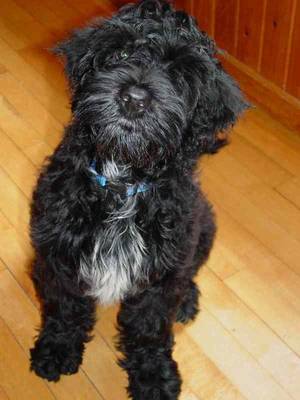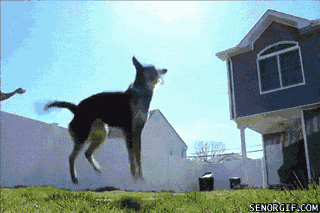

Nova Scotia Duck-Tolling Retrievers are so cool so why don't you have a look at some facts about them!
#1. "The Nova Scotia Duck-Tolling Retriever looks somewhat like a small Golden Retriever."
#2. "It is a well-muscled dog that is medium to heavy boned."
#3. "It has a deep chest that is well-insulated for swimming in cold water."
#4. "The coat is dense, and comes in various shades of red and orange. It usually has small white markings on the feet, chest, tail tip and sometimes face and may have a slight wave on its back, but the coat is otherwise straight."
#5. "The ears are triangular and set high and are well back from the skull."
#6. "The head is clean-cut and slightly wedge-shaped."
#7. "The powerful, compact, well-muscled body is on sturdy, solid legs."
#8. "Sensible and very devoted to its family."
#9. "These dogs are intelligent, easy to obedience train and good with children."
#10. "They make great companion dogs as long as they get enough exercise to fulfill their energetic needs."
#11. "Tollers may be a bit more reserved around strangers than the Golden Retriever, socialize them well."
#12. "The same charming way this water dog has with its game, it demonstrates with its owner."
#13. "This dog is hard-working and clever, and enjoys being with his master."
#14. "His expression may seem low-spirited, but once in the hunt he is the happy hunter."
#15. "The Toller's strong retrieving desire and playfulness are natural traits, both necessary for his tolling ability. Tolling (luring) is a natural trait (like pointing) and cannot be taught. They have an intense natural excitement about their duty."
#16. "Young dogs need to practice; training sessions involve establishing a close relationship and having children throw things for them to retrieve. Some owners say the Toller is a retrieving fool. They love retrieving games!"
#17. "These are excellent family pets which get on well with other dogs and animals."
#18. "They are very patient with children."
#19. "They bark when there is danger but that is likely to be all."
#20. "They need owners who know how to properly communicate authority over them."
#21. "Height: 17-21 inches (43-53 cm.)"
#22. "Weight: 37-51 pounds (17-23 kg.)"
#23. "This is a healthy working breed that is increasing in popularity. With its limited gene pool, a corresponding increase in some health dangers have occurred. Besides some thyroid and autoimmune problems, progressive retinal atrophy is starting to show up."
#24. "The Nova Scotia Duck-Tolling Retriever will do okay in an apartment if it is sufficiently exercised. They do well in cold climates."
#25. "These high energy dogs need a lot of physical exercise. They need to be taken on a brisk, long, daily walk or jog. While out on the walk the dog must be made to heel beside or behind the person holding the lead, as in a dog's mind the leader leads the way, and that leader needs to be the human. In addition, they will enjoy it if you throw a ball or stick for them to retrieve."
#26. "Life Expectancy: About 12-14 years."
#27. "The water-repellent, double coat of the Nova Scotia Duck-Tolling Retriever should be combed and brushed with a firm bristle brush, paying particular attention to the dense undercoat. Dry shampoo regularly, but bathe only when necessary for it removes the natural oils in the skin which make it naturally water resistant. This breed is an average shedder."
#28. "The Nova Scotia Duck-Tolling Retriever originates from Canada. Tolling Red Decoy Dogs probably accompanied their masters from Great Britain to Nova Scotia. They were crossed with retrievers and working spaniels. It was developed to toll (lure) ducks in the manner of the fox. The clever manner in which foxes work together to obtain a duck dinner has been observed over the centuries. The Nova Scotia Duck-Tolling Retriever is the creation of skillful Canadian hunters. The Toller's rather unusual job is to lure ducks and geese within shotgun range, and to retrieve them from the water after they have been hit. From his concealed blind near the shore, the hunter tosses a stick parallel to the shore, and with great liveliness, but without barking, the Toller retrievers it. It may take a dozen or more throws before the ducks or geese become curious and approach the shore. When the overly inquisitive ducks are within shooting range, the hunter calls his dog back to the blind, stands up to put the birds to flight, and shoots. The Toller then acts as an efficient retriever. Indians utilized this mesmerizing practice by stringing a fox skin across a length of shore and yanking it quickly back and forth, simulating the movement of the fox. The breed used to be called the Little River Duck Dog or Yarmouth Toller, but when the Canadian Kennel Club began registering them in the late 1950's, the present name was established. FCI gave them full international recognition in 1982. There are a fair number of Tollers and breed specialty clubs in the USA. The Nova Scotia Duck-Tolling Retriever was first recognized by the AKC in 2003."
Info from: http://www.dogbreedinfo.com/novascotiaducktolling.htm
Pic of Toller face from: http://www.thebestofbreeds.com/catalog/images/NovaScotiaDuckTollingRetriever.jpgPic of Toller standing in grass from: http://www.pedigree.co.nz/breeds/images/nova_scotia_duck_t_ret_03.jpg




















